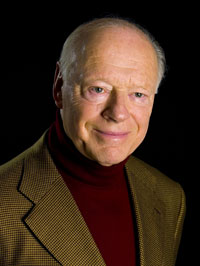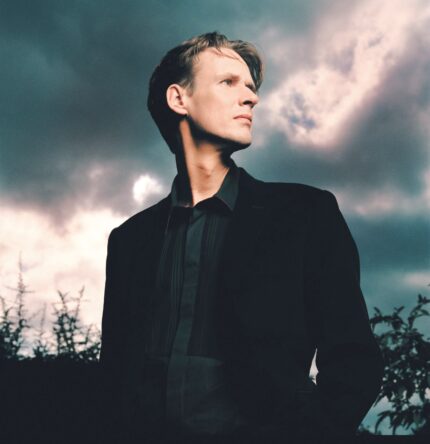Haitink, CSO majestic in final Shostakovich symphony

Dmitri Shostakovich and Benjamin Britten were admirers of each other’s music, and became close professional friends. Britten dedicated The Prodigal Son to his Russian colleague and Shostakovich, in turn, inscribed his Fourteenth Symphony to Britten.
Both composers are represented at this week’s Chicago Symphony Orchestra concerts with Bernard Haitink pairing an early Britten success with one of Shostakovich’s final works, the Symphony No. 15, Thursday night at Orchestra Hall.
Shostakovich is often thought of as a depressive, chain-smoking wreck, but his last symphony—a genre he defined in the 20th century—is anything but lachrymose or self-pitying. While there are tragic overtones and the Adagio defines Shostakovich’s patented bleak introspection, there is also much sardonic humor, with quotations from Rossini’s William Tell Overture, Shostakovich’s own works, and, less cheerfully, Wagner’s Ring.
The engaging lack of pretension is all the more striking in the symphony that Shostakovich knew would be his last. Rather than a grandiose summing up, Shostakovich’s farewell to the symphony is often more of a Petrushka-like nose-thumbing, likely directed at the Soviet commissars who made so much of the composer’s creative life a living hell.

Haitink, who conducted while seated, looked frail as he walked slowly to the podium with a cane, but the power and eloquence of this performance showed the vigor of his direction and that the CSO’s principal conductor remains totally in command.
Haitink’s patient sobriety and rock-ribbed musical integrity pay great dividends in this music, investing even Shostakovich’s most bizarre moments with a gravitas and weight that make the music seem more profound than it possibly is. The Dutch conductor’s precisely scaled dynamics, scrupulous balances and sense of the long line allowed climaxes to register with brilliant impact yet without any sense of inflation or rhetoric.
The heart of the symphony is the long slow movement, given a spacious rendering with Haitink and the CSO musicians distilling a rapt feeling of time standing still. Even by the standard of this conductor and orchestra, the hairpin dynamics and range of hues were remarkable throughout this performance, with magnificent playing across the board and outstanding solo contributions from cellist John Sharp and clarinetist John Bruce Yeh. The symphony’s coda as the once-whimsical percussion kerfluffle grows more segmented and fades away to silence, gave the powerful sense of a master composer drawing the curtain down on his own private, idiosyncratic terms.
Benjamin Britten started writing Les Illuminations in England but completed the work in America during his wartime sojourn. These ten brief settings of Rimbaud poems offer one of Britten’s early masterworks, the song-cycle encompassing a kaleidoscopic range of fantastical imagery, homoerotic sensuality, even urban dislocation.

Ian Bostridge possesses the light voice and natural ease for this repertoire, the rail-thin singer’s brand of wan melancholy eminently suited to these songs. The English soloist proved fully in synch with the elliptical expression of these strange, astringent settings Thursday night. Singing with both refinement and immediacy, Bostridge stood so close to the edge of the Orchestra Hall stage, one was fearful he might accidentally step off.
His flexible instrument easily rode the twists and turns of Britten’s restless vocal line, Bostridge neither overdoing the drama nor understating it. The tenor floated a beautifully graded diminuendo at the end of Phrase, conveyed the waltz-like languor of Antique, and brought suffused romantic ardor to Being Beauteous, a love song to Britten’s then-new partner Peter Pears. The soloist brought the cycle full circle, closing the final setting, Depart, with a glowing repose and quiet resolution.
From the opening trill and collision between B flat and E major, Britten’s spare, ingenious scoring for string orchestra was masterfully directed by Haitink, who held the vigorous nervous energy and lyricism in a fine balance, Concertmaster Robert Chen contributed gleaming, pure-toned violin solos.
For decades, Britten’s most performed work was his Young Person’s Guide to the Orchestra, a set of brilliant variations based on a theme of Henry Purcell. It was fitting then that the evening began with a more recent Purcell retooling, his Music for the Funeral of Queen Mary “transcribed and elaborated” by Steven Stucky.
Stucky chose three sections for his ten-minute arrangement, and the American composer’s 1991 confection works best when it is most straightforward. Purcell’s score has a baleful power and unsettling stark grandeur—brilliantly mined by Stanley Kubrick in the opening of A Clockwork Orange—and under Haitink’s attentive direction, the CSO winds and percussion gave the music polished and stentorian advocacy.
Yet Stucky, who holds great affection for Purcell’s music, also calls this transcription “an exercise in restoration and self-exploration” and that’s where the rubber leaves the road. Stucky’s 20th-century accretions and harmonic quirks sound alien and decidedly self-conscious next to Purcell’s dark majesty.
The program will be repeated 8 p.m. Saturday and 3 p.m. Sunday. www.cso.org; 312-294-3000
Posted in Performances





Posted May 12, 2009 at 10:07 am by Jack
Larry,
Pleased to see you are up and running in Chicago. Site looks great. All the best.
Jack Firestone
Miami, FL